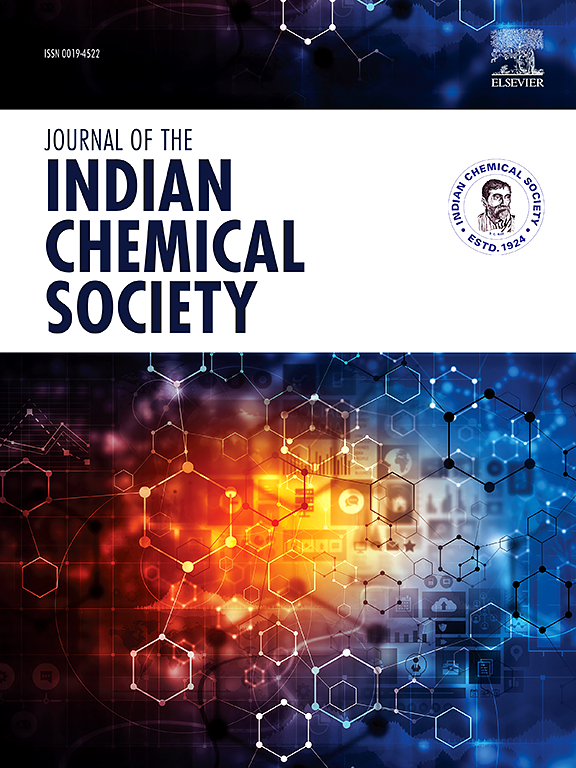Copper nitrate for galena activation: A surface chemistry study of xanthate adsorption
IF 3.2
4区 化学
Q2 CHEMISTRY, MULTIDISCIPLINARY
引用次数: 0
Abstract
The efficient recovery of lead by selective flotation of galena (PbS) is crucial, yet often hindered by its insufficient inherent hydrophobicity, necessitating surface activation. While copper sulfate (CuSO4) is a conventional activator, the potential and mechanistic details of alternative copper salts, particularly copper nitrate (Cu(NO3)2), remain largely unexplored for galena activation. This study, for the first time, systematically investigates copper nitrate (Cu(NO3)2) as an activator for galena, focusing on its impact on surface chemistry and subsequent potassium ethyl xanthate (KEX) adsorption. Copper sulfate (CuSO4) was employed as a well-established benchmark to evaluate the relative activation power of Cu(NO3)2. A suite of analytical techniques, including X-ray Diffraction (XRD), Fourier Transform Infrared Spectroscopy (FTIR), Scanning Electron Microscopy (SEM), and Energy-Dispersive X-ray Spectroscopy (EDS), was utilized to characterize the induced surface modifications.
Results demonstrate that Cu(NO3)2 facilitates KEX adsorption, leading to the formation of copper-xanthate complexes. This was supported by characteristic XRD peaks (e.g., at 2θ = 24.37°, 18.40°) and FTIR absorption bands (e.g., at 1197 cm−1). SEM imaging revealed moderate surface roughening, and EDS analysis confirmed copper deposition at an atomic concentration of 0.11 %. In comparison, the benchmark CuSO4 activation resulted in more extensive copper-xanthate formation, indicated by significantly more intense XRD and FTIR signals (e.g., 2θ = 19.63°, 28.35°), more pronounced morphological changes, a higher copper deposition of 0.39 %, and a corresponding sulfur enrichment to 50.70 % S.
These findings establish Cu(NO3)2 as a viable, albeit less potent activator than CuSO4 under the studied conditions (0.11 % vs. 0.39 % Cu deposition). This research provides the first detailed surface-chemical evidence of this activation, quantifying elemental changes and highlighting the differential impact of the counterion. This work contributes foundational knowledge for optimizing flotation schemes to improve the efficiency and sustainability of lead ore processing.

硝酸铜活化方铅矿:黄原药吸附的表面化学研究
方铅矿(PbS)的选择性浮选对铅的有效回收至关重要,但由于其固有疏水性不足,需要进行表面活化,因此常常受到阻碍。虽然硫酸铜(CuSO4)是一种传统的活化剂,但替代铜盐的潜力和机理细节,特别是硝酸铜(Cu(NO3)2),在方铅矿活化方面仍未得到充分研究。本研究首次系统地研究了硝酸铜(Cu(NO3)2)作为方铅矿的活化剂,重点研究了其对表面化学和随后的乙基黄药钾(KEX)吸附的影响。以硫酸铜(CuSO4)作为评价Cu(NO3)2相对活化力的基准。利用x射线衍射(XRD)、傅里叶变换红外光谱(FTIR)、扫描电子显微镜(SEM)和能量色散x射线光谱(EDS)等分析技术对诱导的表面修饰进行了表征。结果表明,Cu(NO3)2有利于KEX吸附,形成铜-黄药配合物。XRD特征峰(如2θ = 24.37°,18.40°)和FTIR吸收带(如1197 cm−1)支持了这一点。扫描电镜(SEM)显示表面有一定程度的粗化,能谱(EDS)分析证实原子浓度为0.11%的铜沉积。相比之下,基准的CuSO4活化导致了更广泛的铜黄药形成,从更强烈的XRD和FTIR信号(例如,2θ = 19.63°,28.35°),更明显的形态变化,更高的0.39%的铜沉积和相应的50.70%的硫富集来看,这些发现表明Cu(NO3)2是一种可行的活化剂,尽管在研究条件下,Cu(NO3)2的活性不如CuSO4 (0.11% vs. 0.39%的Cu沉积)。这项研究提供了这种活化的第一个详细的表面化学证据,量化了元素的变化,并强调了反离子的不同影响。这项工作为优化浮选方案提供了基础知识,以提高铅矿处理的效率和可持续性。
本文章由计算机程序翻译,如有差异,请以英文原文为准。
求助全文
约1分钟内获得全文
求助全文
来源期刊
CiteScore
3.50
自引率
7.70%
发文量
492
审稿时长
3-8 weeks
期刊介绍:
The Journal of the Indian Chemical Society publishes original, fundamental, theorical, experimental research work of highest quality in all areas of chemistry, biochemistry, medicinal chemistry, electrochemistry, agrochemistry, chemical engineering and technology, food chemistry, environmental chemistry, etc.

 求助内容:
求助内容: 应助结果提醒方式:
应助结果提醒方式:


